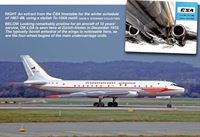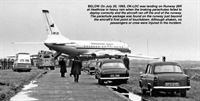Фотографии
-
The Tupolev Tu-104A was known as the “Brontosaurus” in Czechoslovakian service.
Самолёты на фотографии: Туполев Ту-104 - Россия - 1955
-
Регистрационный номер: OK-LDC [4] CSA’s third “Brontosaurus”, OK-LDC, at Nicosia, Cyprus, in 1971.
Самолёты на фотографии: Туполев Ту-104 - Россия - 1955
-
Регистрационный номер: OK-LDA [3] Retired in September 1973, OK-LDA was donated to the Kbely Aviation Museum, Prague, where it spent more than 30 years deteriorating in open storage. It is seen here in 1995. Happily, the historic jetliner was restored to pristine condition in 2007, in the CSA colours in which it spent most of its career. It remains on display at Kbely.
Самолёты на фотографии: Туполев Ту-104 - Россия - 1955
-
Регистрационный номер: OK-LDC [4] Fitted only with Fowler-type flaps and no other low-speed wing devices, the Tu-104A’s landing speed was high, Flight reporting that it “certainly seemed fast, though not hot, with quite hard braking causing expensive-sounding noises in the mid-ships galley”. Here OK-LDC initiates the flare on landing at Heathrow on June 30, 1968.
Самолёты на фотографии: Туполев Ту-104 - Россия - 1955
-
Регистрационный номер: OK-LDA [3] Looking remarkably pristine for an aircraft of 15 years’ service, OK-LDA is seen here at Zurich-Kloten in December 1972. The typically Soviet anhedral of the wings is noticeable here, as are the four-wheel bogies of the main undercarriage units.
INSET: An extract from the CSA timetable for the winter schedule of 1967-68, using a stylish Tu-104A motif.Самолёты на фотографии: Туполев Ту-104 - Россия - 1955
-
Регистрационный номер: OK-NDF Named Ceske Budejovice in CSA service, OK-NDF originally served with the Aeroflot fleet as CCCP-42391, before being the last Tu-104 delivered to the Czechoslovakian airline in February 1963. It is seen here at Paris-Orly in July 1965. Note the three roof windows to the port side of the cabin centreline, used to provide light in the galley.
Самолёты на фотографии: Туполев Ту-104 - Россия - 1955
-
Регистрационный номер: OK-LDB Wearing CSA’s newly introduced colour scheme of white upper fuselage, aluminium lower surfaces and red titles, cheatlines and stylised bird motif, the airline’s second Tu-104A, OK-LDB Bratislava, awaits its next service at Heathrow in August 1960. The type replaced Il-14s on the London-Prague service on April 1, 1960.
Самолёты на фотографии: Туполев Ту-104 - Россия - 1955
-
One of CSA’s six Tu-104As trails its pair of braking parachutes on landing. Repacking and re-installing the parachute cartridge after each landing - on top of the risk of the parachutes tearing or snagging on ground-based equipment and obstacles - must have been something of a nuisance on scheduled services.
Самолёты на фотографии: Туполев Ту-104 - Россия - 1955
-
Регистрационный номер: OK-LDA [3] The first of &SA’s Tu-104As, OK-LDA Praha, taxies in at Heathrow on April 15, 1960, in the original colour scheme in which the type entered service. It featured a blue cheatline running the length of the fuselage, which terminated in a tapering lightning bolt and distinctive "beard" on the forward fuselage.
Самолёты на фотографии: Туполев Ту-104 - Россия - 1955
-
Регистрационный номер: СССР-Л5445 Dawn of a new era - Aeroflot Tu-104A CCCP-L5445.
Самолёты на фотографии: Туполев Ту-104 - Россия - 1955
-
A rare colour photograph of CSA Tu-104A crew at work in the mid-1960s. In the seat is second pilot Flight Officer Josef Turecky, while Flight Engineer Jaroslav Pajer looks on. Note the Tu-104A’s extensively glazed flight deck.
Самолёты на фотографии: Туполев Ту-104 - Россия - 1955
-
The Tu-104A’s cabin accommodated 70 passengers, 16 in a four-abreast first-class configuration (two/aisle/two) in the forward section and 54 in a tourist-class layout of five abreast (three/aisle/two) in the aft section. In 1959, British magazine Flight sampled an Aeroflot Tu-104A, confirming the cabin’s "much-publicised drabness".
Самолёты на фотографии: Туполев Ту-104 - Россия - 1955
-
First-class accommodation in a CSA Tu-104A. Flight’s rather haughty report on flying in the type in 1959 opined that the cabin was "ludicrously out of keeping with the lines and finish of the aircraft, [with] gold-anodised aluminium ‘brass’ racking with nets etc.."
Самолёты на фотографии: Туполев Ту-104 - Россия - 1955
-
Navigator Vladimir Perka plots the route south from Greece, probably Cairo-bound, in the distinctive glazed nose of a CSA Brontosaurus. Sadly, Perka was killed in the crash of Tu-104A OK-NDD at Tripoli, Libya, in June 1970.
Самолёты на фотографии: Туполев Ту-104 - Россия - 1955
-
Регистрационный номер: OK-LDC [4] In 2007 the author’s father, Bob Jindra, was reunited with Tu-104A OK-LDC, now an air restaurant at Petrovice. Bob accrued some 22,000hr as a navigator with CSA on the Tu-104A and various other types including the scaled-down Tupolev Tu-124 and Ilyushin Il-62; but, as the author explains, the “Brontosaurus retained a special place in his heart”.
Самолёты на фотографии: Туполев Ту-104 - Россия - 1955
-
The Tu-104A’s cockpit reflected the airliner’s military origins, with a glazed nose to accommodate the navigator’s station, reportedly easily adaptable into a bomb-aimer’s position. The radio operator’s station was behind the copilot, facing aft. The flight deck glazing incorporated heated double-layered windscreen panels.
Самолёты на фотографии: Туполев Ту-104 - Россия - 1955
-
On March 21,1963, both OK-LDB and OK-MDE overran the runway at Bratislava in one 60min period, closing the airport. One of the two is seen here buried axle-deep in mud. The twin-wheel nose undercarriage unit was fully steerable and retracted rearwards.
Самолёты на фотографии: Туполев Ту-104 - Россия - 1955
-
Регистрационный номер: OK-LDC [4] On July 20, 1965, OK-LDC was landing on Runway 28R at Heathrow in heavy rain when the braking parachutes failed to deploy correctly and the aircraft ran off the end of the runway. The parachute package was found on the runway just beyond the aircraft’s first point of touchdown. Although shaken, no passengers or crew were injured in the incident.
Самолёты на фотографии: Туполев Ту-104 - Россия - 1955
-
Регистрационный номер: OK-MDE On August 29, 1973, OK-MDE Ostrava was landing at Nicosia, Cyprus, on the penultimate leg of Flight OK531 routing through Baghdad-Damascus-Nicosia-Prague, when it ran off the runway and made a turn to the right at high speed, tearing off the port mainwheel before finally coming to rest. All 70 occupants escaped, although nine were injured.
Самолёты на фотографии: Туполев Ту-104 - Россия - 1955
-
A CSA promotional route map extolling the virtues of the airline’s Tu-104A fleet; "minimum travel time, maximum comfort".
Самолёты на фотографии: Туполев Ту-104 - Россия - 1955
-
“Care, Service, Attention = CSA”, according to this Tu-104A promotional brochure distributed by the airline. An important aspect of the jetliner’s introduction into CSA service was the qualitative leap in catering, provided by chefs from the Hotel International in Prague, and featured in three of the brochure’s five photographs!
Самолёты на фотографии: Туполев Ту-104 - Россия - 1955
-
This 1958 CSA timetable uses the futuristic planform of the state-of-the-art Tu-104 on its cover to promote the type’s unique capabilities. With the British Comet grounded until the autumn of 1958, the Tu-104 was the only game in town in terms of jet airliners.
Самолёты на фотографии: Туполев Ту-104 - Россия - 1955
Статьи
- -
- B.Cahill - The USAAF's Mediterranean Ferrets
- B.Lindwall - Whistling in the Dark
- B.Taghvaee - Iran's Weasel Diesels
- D.Zamansky - Airacobra: Hero of the Soviet Union
- E.Wild - Say Cheese! (2)
- J.-C.Carbonel - France's Air Pioneers: Antoine P.Filippi
- J.Forsgren - Nattjakt!
- K.Hayward - Decline & Fall
- M.Jindra - OK-JET! The Tupolev Tu-104A in Czechoslovakia
- N.Follett - Spirit of Australia
- P.Davidson - Off the Beaten Track...
- P.Jarrett - Lost & Found
- P.Lavender - Reflections on a Tragedy
- P.Vabre - From Flying to Spying (1)
- T.Buttler - Struck by Lightning





















